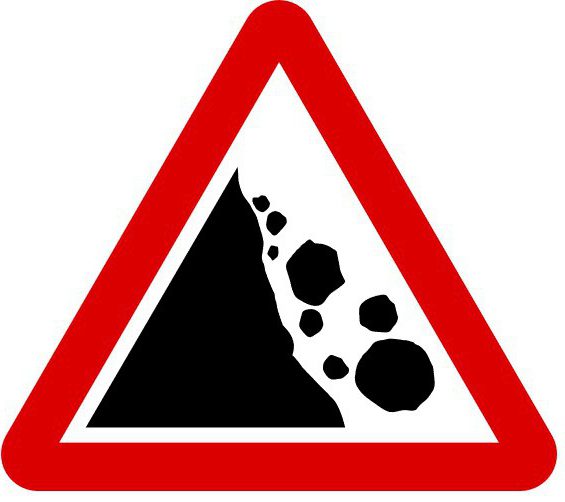One of the most important in traffic regulations is such a topic as warning signs. SDA really describe it in great detail. And in fact everyone should know the signs - and not only the driver. Well, it’s worth briefly talking about this topic.

Definition
To begin with, I would like to briefly tell you what the warning signs are. Traffic rules explain this term as follows: these are the signs that inform the driver that he is approaching a road section where he will face potential danger. And they put them there so that motorists have time to take a series of actions to pass this place without consequences.
In the Russian Federation, such signs are triangular in shape. Their background is white, sometimes yellow (to attract attention). On the signs themselves are black drawings. And of course, there is a red edging. On the territory of the city they are installed 50-100 meters before the start of the site. In the suburbs and suburban areas - for 150-300.
What you need to know
It should be noted that there are still some nuances that distinguish warning signs. Traffic regulations say that these signs, even if they are a signal of an approaching potential danger, in fact do not forbid anything. So, in fact, their requirements cannot be violated - even in theory. And the fine, respectively, does not threaten the driver.
However, despite all of the above, you should not relax. Since often warning signs are placed in front of those areas where violations are punishable by substantial fines.

The first 10 characters to remember
So, it’s worth starting to talk about warning signs in order. SDA numbers them - so it turns out they are easier to remember and later use in theory. And the first signs are warning in nature about everything connected with the railway. Well, we need to list them.
1.1 is the very first of them. It depicts a “fence”, and it means that a railway crossing is nearing, in front of which a barrier is installed. The second is 1.2. It already depicts a train, which means the approach of the railway crossing without a barrier. 1.3.1 and 1.3.2 intersect in meaning. The first of these means moving with one path, and the second with two or more. The way they look can be understood from the above photo.
The following pointers are known as 1.4.1, 1.4.2, 1.4.3, 1.4.4, 1.4.5 and 1.4.6. These are the last six signs, and they all mean approaching the railway crossing. This is an additional warning, and install it outside of settlements. They look like rectangular long plates with obliquely drawn lines - three, two and one. They mean the number of meters left to the train tracks. 3 strips - 150-300 meters. Two - 50-150. One - less than 50. On the left side of the road, signs are installed on which the lines go from bottom to top to the right. On the right - respectively, vice versa.

What is easy to remember
So, above was told about the first warning signs. Traffic rules with comments, in fact, make clear what a particular indicator means. Therefore, remembering them is quite simple. Even according to the picture on the plate. If, for example, a tram is drawn in a triangle, then this means the intersection with the line along which these vehicles follow. Everything is simple! This sign is numbered as 1.5. Next is a signpost, meaning that equivalent roads cross further. This is the triangle inside which the cross is drawn. When approaching such a site, a person, according to the rules, will have to give way to a car approaching on the right.
Signpost 1.7 warns that there will soon be an intersection with a circular motion. Arrows are drawn in a triangle in a circle - so remembering is easy. If a traffic light is drawn in a triangle, then a person should know - he is approaching the intersection where traffic will be regulated by a traffic light.
Another simple sign is 1.9, warning of approaching a ferry or drawbridge. And 1.10 - it means going ashore or promenade.
Dangerous twists
How much the world knows of cases when accidents occurred because a person did not fit into the turn! Do not rely on your skill, because it is not without reason that in advance of this section there are signs under the numbers 1.11.1, 1.11.2, 1.12.1 and 1.12.2. The first two of these warn about the curvature of the road. Having seen such a pointer, you should reduce the speed and move with increased caution.
The second two signs from those listed are those that warn of the appearance of those very dangerous turns. They do not look like the first (a straight line rounded to the end), but like a pronounced zigzag. In this case, you definitely need to reduce the speed - based on your own safety.

Road noise
Warning traffic signs, photos of which are provided below, can sometimes really save lives. Or at least the technical condition of the car. Take, for example, pointers 1.13 and 1.14. They mean steep descent and ascent. Seeing them, a person can reduce speed in advance, reduce gear and calmly pass this obstacle.
Pointer 1.15 means approaching a slippery road. By the way, they are often installed directly in front of this site. So, when you see a sign that shows a car with curved slippery tracks behind it, you should reduce the speed and be especially careful. Index 1.16 is one of the most unloved by drivers. After all, he warns that ahead is a rough road. And these are potholes, waviness, holes - in general, everything, because of which the suspension “flies”. And it happens that a sign is placed under the sign indicating the interval (in meters), during which these same bumps will appear. And here, in Russia, one can often see a four-digit number there.
Index 1.17 warns a person that a speed bump awaits him, that is, an artificial bump. Sign 1.18 is installed in front of the area when moving on which gravel or gravel can be ejected from under the wheels. In general, in order to save your car from technical damage, it is worth teaching traffic rules. Warning road signs need to know - at least for reasons of their own benefit, education and safety.

About road changes
Index 1.19 means a dangerous roadside. That is, a person should go as far as possible from her. Otherwise, it will be possible to slide along the side of the road, for example, into a cliff. Anything can happen, especially in the highlands.
You also need to remember the meaning of the pointers 1.20.1 - 1.20.3. They warn of a narrowing of the road. And how exactly it will be narrowed can be understood directly from the image on the triangular plate.
You should also remember the meaning of the labels 1.34.1, 1.34.2 and 1.34.3. They are the last in the list of warning, but also relate to changes on the road. And they mean the direction of rotation. They look like a long rectangular narrow plate of red color with numerous white arrows. In general, wherever they point, they should go there.

What to look for
What was listed above is not all that traffic rules can tell. Warning signs with explanations are numerous, and all of them must be known, as this will come in handy. For example, pointer 1.21. Means two-way traffic. And each driver must know when he leaves for where oncoming cars appear.
1.22 and 1.23 are also important warning signs of traffic rules.And their description is as follows: the first of the listed means a pedestrian crossing, and the second - the sudden appearance in the middle of the carriageway of children (installed near schools, camps, etc.). There is also a pointer 1.24 - it warns of approaching the bike path. There, it is also desirable to reduce the speed. A sign 1.25 put where they repair the pavement.

What is rare
1.26, 1.27, 1.28, 1.29 and many others are very rare, but warning signs prescribed in traffic rules. Their value is also worth knowing. 1.26 is cattle driving. That is, on the road you can see cows, for example. 1.27 warns of the possible appearance of unusual animals. That is wild. Do not be surprised if by chance a deer runs out from somewhere in the bushes. 1.28 is a pointer indicating the fall of stones. He is also worth knowing, since he talks about the likely occurrence of landslides, landslides and other things. 1.29 - a sign warning of departure to a site where side wind is possible. 1.30 means airplanes flying low above the ground, 1.31 - a tunnel without lighting, 1.32 - traffic jam (or traffic jam, as they say). And the last pointer is 1.33. It looks like an exclamation point and stands for simple - other dangers.
As you can see, there are many signs in general. But with due care and diligence it is easy to remember them. Moreover, then they meet regularly on the roads.
